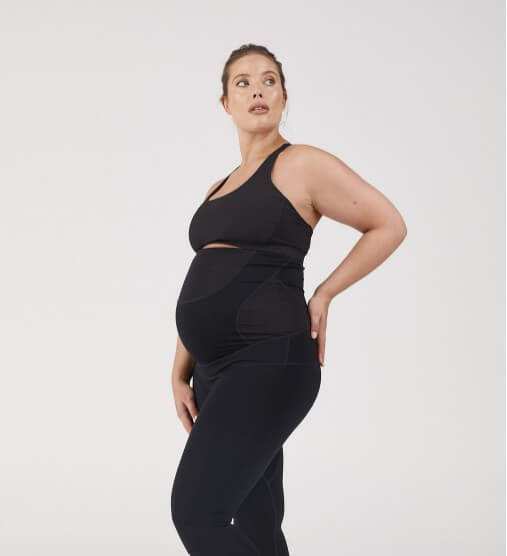Pelvic Pain During Pregnancy

What is pelvic pain in pregnancy (PGP)?
Pregnancy comes with a lot of changes to your body. Some people, including those who had bad period pain before they became pregnant, may find they have less pain in pregnancy. Others, including some women who had no pain concerns before pregnancy, develop new pains associated with the muscles, ligaments, fascia, bones, joints and organs of the pelvis. Pain during or after pregnancy affects around 6 in 10 women. It is usually described as pain, stiffness or soreness and can be felt in the pelvis or in the lower back.
Three common types of pelvic pain during pregnancy:
Image: Diagram of front and back of the pelvis indicating the pubic symphysis and Sacroilliac Joints.
Pelvic Girdle Pain (PGP)
The bones that join together to form the pelvis are called the pelvic girdle. The joint at the front is the pubic symphysis and the joints to either side of the middle at the back are the sacroiliac joints. These joints can get stretched and sore during or after pregnancy, with pain that can be mild, but can also be severe. You can see the bones and joints in [picture]. Muscles attach to the bones and can also be affected.
Different women will have pain in different areas, depending on which parts of the pelvic girdle are most affected. –Pain at the back of the pelvis, and usually on one side, is called sacro-illiac joint (SIJ) pain. Pain near the Symphysis Pubis (the joint at the front in the middle) is called Symphysis Pubis Dysfunction (SPD). It is important to note that your pelvis is not “unstable”. The pelvis contains some of the most stable joints in the body, but there is a small amount of increased movement at the pelvic joints which assists with the birth process, but can contribute to pain. We now recognise that pelvic girdle pain in pregnancy is due to more than just the impact of pregnancy on our posture, hormones and biomechanics, and has inputs from our stress and nervous system, beliefs about pain and other social factors.
Prolapse of the Uterus or Vagina
Pregnancy and vaginal delivery of a baby stretch the tissues of the pelvis, pelvic floor and vagina. After the baby is born, the uterus, bladder or bowel can lie lower in the pelvis than before, and can start to protrude into the vaginal canal. Once again, we are all different, and some women’s vaginal tissues and pelvic ligaments stretch more than others. Pelvic Organ Prolapse, or POP, is the result of this stretching and softening, and it can cause descent of the organs inside the pelvis to the opening of the vagina, or sometimes beyond the opening. There might be a bulge that you can feel or see with a mirror at the opening of the vagina, or an aching feeling as the lowered pelvic organs sit differently in the pelvis and may pull on ligaments and nerves of the pelvic girdle.
Vulval Varicosities
These are enlarged, engorged veins in the vulval tissues. This is the area outside the vagina between your legs. They are similar to the enlarged, engorged veins some people have in their legs. Men can have varicose veins of their scrotum. Vulval varicosities affect around 1 in 10 pregnant women. They are caused by the hormonal changes of pregnancy, and pressure from the weight of the baby in your pelvis.
Why does pelvic pain in pregnancy occur?
It has generally been accepted that most pelvic pain in pregnancy is the body’s response to the hormone and blood vessel changes of pregnancy. However we have evolved our thinking to encompass many more complex inputs, aside from just the changes in the body posture and hormones.
During a normal pregnancy, the body makes extra hormones to relax the pelvis and gradually allow for widening of the pelvis in preparation for birth. It also makes more blood to ensure that you and the baby receive the nutrition you need during pregnancy, and to allow for the blood that is lost during birth. It is an incredible phenomenon that the body intelligently produces hormones that allow these changes to occur. Despite these changes of pregnancy being normal, many women can experience pain in the front, back or sides of the pelvis as the body changes to accommodate their growing baby.
We also now recognise that pelvic pain in pregnancy has inputs from our central nervous system, and factors such as stress and the state of our nervous system, as well as our beliefs about the pain are all as important, if not more important than addressing structural, or postural changes. Understanding the pain and triggers for your pain, as well as keeping mobile are the 2 most important things that you can do.
How do I get better?
- Understanding pain, and that your body is fit for purpose
Your Body is Fit for Purpose
Physiotherapist and Professor of Neuroscientist Lorimer Mosely talks about the “Fit for Purpose” model, which explains that your body “is fit for purpose,” even if it doesn’t feel like it. It is the pain system that has become hypersensitive, and makes you feel like something might break, even though it is not going to. He talks about stopping moving in “the way that pain moves’ - being rigid, fearful or avoidant. Pain has an ‘anticipatory” function in the bpdy, and can become hardwired in transitions or movements. So to move past it, he encourages mindful practices, breathing and connecting with your body, learning to ”downregulate” your nervous system, starting small with movement and building up as pain allows. Breathing practices, Such as Non Sleep Deep Rest, Yoga nidra, Yoga practices, can all help with calming a sensitised nervous system.
2. Graded exercise
Novel graded exercise; starting small, novel daily movements, getting them to connect to their breath, and being mindful in the transition - something like a squat, sit to stand, bridges; Yoga is really effective as it has the component of mindfulness, breathing, nervous system downregulation; and then gradually building up in terms of load as able. Lorimer Mosely talks about the “Fit for Purpose” model and that explaining to patients that although their body is fit for purpose, even if it doesn’t feel like it; that their pain system is hypersensitive and feels like you are going to break, but you are not. That pain is anticipatory and can be hardwired in to trasitions and movements over time. the y need to stop moving in the way that fear moves - gripping, co-contracting, rigid.
It’s not that exercise is not incredibly important in improving PPGP symptoms - it is and should be a mainstay of the care plan. But, we need to think about how we communicate this to patients - not ‘stabilty” exercises, even though there are numerous benefits from these styles of exercise/ rehab - but we are insinuating a lack of stability if we are recommending stabilisation exercises, we may use simlar exercises but call them “co-ordination” exercises or brain training exercises. Novel graded exercise; starting small, novel daily movements, getting them to connect to their breath, and being mindful in the transition - something like a squat, sit to stand, bridges; Yoga is really effective as it has the component of mindfulness, breathing, nervous system downregulation; and then gradually building up in terms of load as able. Lorimer Mosely talks about the “Fit for Purpose” model and that explaining to patients that although their body is fit for purpose, even if it doesn’t feel like it; that their pain system is hypersensitive and feels like you are going to break, but you are not. That pain is anticipatory and can be hardwired in to transitions and movements over time. the y need to stop moving in the way that fear moves - gripping, co-contracting, rigid.
Reducing Load and Triggers:
Pain in the pelvis, regardless of where it occurs can be quite debilitating, but there is lots you can do to be more comfortable.
Self-Care
These are things you can do easily yourself without needing to see a health practitioner:
In the short term, you can address load and aggravating activities by:
- Wearing comfortable and supportive shoes with a low heel
- Taking smaller steps (as if wearing a tight, short skirt)
- Going up and down stairs one at a time
- Keeping your knees together when getting in and out of a car. A great tip is to pop a plastic shopping bag underneath you on the seat so you can swivel your bottom easily on the seat with knees together.
- Sleeping with a thick pillow between your knees, and a specially designed ‘bump pillow’ under your pregnant tummy. This will take some of the twisting pressure off your hips, pelvis and lower back when lying in bed
- Rolling to your side first before you get out of bed, or up from a couch, keeping your knees together.
- Avoid sitting on the floor (as this often involves crossing the legs or sitting with legs wide, as well as bearing weight more on one leg when you stand back up) and avoid sitting with your legs crossed at your desk
- Thinking about the exercise you enjoy doing. When you have pelvic girdle pain, it is best to switch to low impact activities like strength training, swimming or pilates rather than walking or jogging if this causes irritation. There is more information on this below.
These are garments you can wear to reduce pain. They work by reducing the painful movement in the joints and supporting the pelvic organs. If you are already seeing a pelvic physiotherapist, you can ask them about pelvic support garments. If not, you can order them yourself online from Australian company, Everform, at everform.com.au.
Examples of suitable garments include the Everform Therapywear Support Maternity Shorts or Leggings for Sacroilliac joint and pelvic girdle pain, and pelvic floor support.
Working with a Pelvic Physiotherapist
Your local women’s health physiotherapist or osteopath is a fantastic resource. They are specifically trained in the changes that happen during pregnancy, as well as pelvic health across the lifespan of women and those assigned female at birth.
Once the joints of the pelvic girdle become painful, or pelvic organ prolapse occurs, it is common for the muscles inside the pelvis to become painful too. Sometimes they become weak, while in other situations they become overactive and painful. A pelvic health specialist can help by assessing the whole pelvic girdle, the pelvic muscles and the vagina for pelvic organ prolapse. A women’s health physiotherapist can also talk to you about lifestyle factors that may be contributing over and above the normal pregnancy hormones.
To help with the cost of pelvic physiotherapy, your GP may be able to prepare a physiotherapy ‘Care Plan’ for you. This supports a large part, but not all, of the cost of seeing a pelvic physiotherapist.
Staying Active
Staying physically active (where possible) can be so beneficial for not only you, but your baby, and there are plenty of pelvic pain friendly exercise options. Studies show that women who exercise 3 times per week for 30 mins or more have shorter labours when giving birth, and recover faster than women who don’t exercise. Your baby also benefits from your regular activity, as the vibration stimulus of your movement helps their development. This is true as long as your exercise is not excessive. During pregnancy it is best to avoid harmful activities, or exercise where you push yourself hard. This includes high speed exercise, exercise with frequent changes of direction or exercise with a high risk of falls or contact injury. Fascinatingly, IQ scores of babies of mothers who exercise regularly in pregnancy are higher at 1 year than those who were avoided exercise in pregnancy.
The right exercise for you will depend on how irritable your pelvis is and whether your pain involves the Symphysis Pubis (the joint right at the front), or the Sacroilliac Joint (the joints a bit to the side at the back).
Exercises that are great for women with pelvic pain during pregnancy include:
- Swimming with a pool flotation device like a noodle. Avoid breaststroke or intense kicking as these will be painful.
- Pregnancy pilates. Some physiotherapists offer small group pregnancy classes, so you’ll be a group you have lots in common with.
- Strength training. This is still possible if you are careful. Depending on how you are feeling, you may need to only exercise your upper body, or modify the lower body exercises at times. Avoid exercise that involves standing on one leg, or where the weight is distributed unevenly between the legs. This includes lunges or step ups. You may also need to reduce the depth of your squats to avoid irritating your pain. Lifting weights should only be done under the advice of your doctor or physiotherapist if your concern is pelvic organ prolapse.
- Cycling. This suits some women but not others. If cycling, try a lower resistance setting and start with a short exercise time (maybe 5 minutes only). If all goes well, you can slowly build up by 5 mins at a time.
Exercises to be careful of if you have pelvic pain during pregnancy include:
- Walking and running. Unfortunately, these exercises can aggravate pelvic pain. As short walks may be tolerable, you could try breaking your walking up into a few shorter bursts across the day rather than one long walk. When walking, avoid taking longer strides or power walking.
- Yoga. Yoga involves stretching, which can be great in our normal lives, but can aggravate pelvic pain in pregnancy when the joints are looser. Stances with the legs spread widely or with the weight on one leg are a particular aggravator. A prenatal yoga teacher will understand this and may be able to modify the exercises to avoid aggravation of pain.
- Body Contact Sports. It is wise to avoid sports where body contact is a risk during pregnancy. Ball sports in particular often aggravate the pelvis as they involve running, jumping, changing direction and a lot of movement for your pelvis!
Will my pelvic pain go away after having my baby?
For most women, their pelvic pain naturally resolves in the first 6 weeks or so after the birth of their baby. Hormone levels return to normal and taking time to rest where you can during this time helps too. If you are still experiencing pelvic pain at your 6-week check-up, make sure you mention it to your health professional. They can press over the joints to see if they are tender and check your vagina to see if there is prolapse of the pelvic organs. You can also read about pelvic pain after pregnancy on this site, here.
Could my pain be a sign of something dangerous?
The types of pelvic pain we’ve talked about here are the common types. Rarely, pelvic pain can be a sign of other illnesses. It is important to speak to your health professional promptly if you have:
- Pain that is getting worse
- Redness or swelling of the hip, upper thigh or vulva
References
Exercising throughout your pregnancy (2012). Clapp, J MD, Cramm, C MD. Addicus Publishing.
Factors associated with persistent pain after childbirth: a narrative review – PMC (nih.gov)
The Royal Women’s Guide to 3rd and 4th Degree tears Fact Sheet




